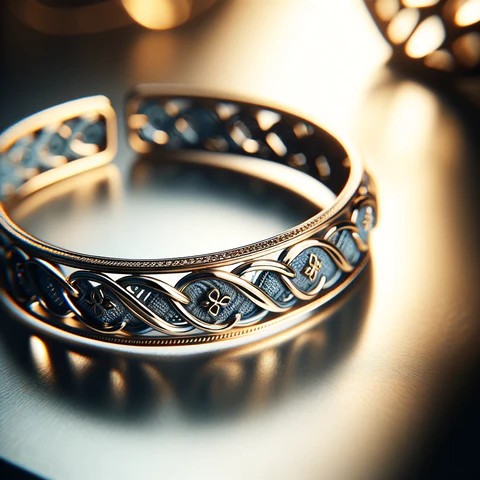You’ve likely encountered the term “14k gold” when browsing for or learning about gold jewelry. But what does 14k gold really mean? How can you identify 14k gold jewelry? And crucially, how much is 14k gold worth today? Are certain types of 14k gold jewelry more valuable than others? Let’s delve into the world of 14k gold and uncover its value.
Understanding Karats and Gold Purity
Let’s begin with a quick explanation of karats. A “karat” (often abbreviated as “k” or “kt”) is a unit of measurement that indicates the proportion of gold in a piece of jewelry or other item. Pure gold is designated as 24 karats, meaning it consists of 24 parts gold out of 24 total parts. When the karat number is lower than 24, it indicates a lower proportion of gold, with the remaining material composed of other metals. For instance, 14k gold signifies that the item is made up of 14 parts gold out of 24, making it approximately 58.3% pure gold.
14k gold is a popular and widely used alloy in the jewelry industry, favored for its balance of versatility, durability, and aesthetic appeal. 14k gold items are more accessible in terms of cost compared to 18k or 24k gold, while still maintaining an attractive appearance and offering good durability for everyday wear.
If 14k gold is 58.3% gold, what constitutes the remaining 41.7%? The other metals often alloyed (mixed) with pure gold in jewelry creation include copper, silver, nickel, palladium, platinum, zinc, and even aluminum. The addition of these non-gold metals contributes to the strength, resilience, and scratch resistance of 14k gold items.
The Colorful World of 14k Gold Alloys
Pure gold is mixed with various metals to create gold alloys with unique appearances. Here’s a look at some common and less common types of 14k gold:
White Gold
White gold possesses a silver-like appearance and is created by combining pure gold with white metals like nickel, palladium, or silver. A thin layer of rhodium is sometimes applied to enhance the whiteness and improve durability. White gold gained traction in the early 20th century as a substitute for platinum, which was both scarce and expensive at the time (and remains rarer than both gold and silver today!). It’s a popular choice for engagement rings, wedding bands, earrings, and men’s jewelry.
Rose Gold
Rose gold, sometimes called pink gold or red gold, is distinguished by its pinkish or reddish hue. It is made by alloying pure gold with copper, and sometimes a small amount of silver. The copper content dictates the intensity of the color; a higher copper percentage results in a deeper reddish tone. In recent years, rose gold has enjoyed increased popularity due to its romantic and vintage aesthetic, making it a common choice for engagement rings, wedding bands, bracelets, and watches.
Yellow Gold
Yellow gold retains the natural warm, yellowish color of gold. It’s usually made of pure gold combined with copper and/or silver. Yellow gold is a classic choice for jewelry, valued for its timeless appeal and versatility.
Green Gold
Yes, green gold exists! Also known as electrum, green gold is a naturally occurring alloy of gold and silver that exhibits a greenish tint. The ratio of gold to silver can vary, influencing the color from a pale green to a more intense shade. Green gold is relatively rare and has been used in jewelry making throughout history, particularly in ancient civilizations such as the Egyptians and Greeks. While still occasionally used in jewelry for its unique color, it is less common than white, rose, and yellow gold alloys.
 Luxurious bracelet crafted from blue-hued gold
Luxurious bracelet crafted from blue-hued gold
Other Unique Alloys: Blue and Purple Gold
Rarer still, blue gold is alloyed with metals that create a bluish tint, such as iron, cobalt, or aluminum. Blue gold may require special care to maintain its color and appearance.
Purple gold, also known as amethyst gold or violet gold, is an alloy of gold and aluminum. It’s relatively stable and resistant to tarnishing and has long been associated with royalty and luxury!
Determining How Much 14k Gold is Worth
So, is 14k white gold worth more than 14k rose, yellow, or green gold? The answer is subjective. When comparing different 14k alloys, each type of alloy should contain the same amount of pure gold. The non-gold metals used are generally present in such small quantities that differences in their market values have minimal impact on the overall value of a single piece of jewelry.
However, it’s crucial to distinguish between the retail value of 14k jewelry and its precious metal value (also known as “scrap value” or material value). Retail and resale prices are influenced by factors such as the designer, design intricacy, rarity, and the value of any non-metal components, like precious stones. A designer diamond ring, for instance, will likely command a higher retail price than an old 14k gold necklace or bracelet, even if the gold content is the same.
Estimating the Scrap Value of 14k Gold
Calculating the approximate scrap value of a 14k gold item is relatively straightforward. Here’s how:
Let’s consider a 14k gold ring that weighs 4 grams as an example:
- Convert the item’s weight in grams to troy ounces: 4 grams = 0.128603 troy ounces.
- Multiply the weight in troy ounces by the current price of gold: 0.128603 x (current gold price – example: $2,035.05) = $261.71. Note: You’ll need to find the current price of gold to get an accurate estimate.
- Calculate 58.3% of that number: $261.71 x 0.58 = $151.79.
Therefore, a 14k gold ring weighing 4 grams would have a scrap value of approximately $151.79, based on a gold price of $2,035.05 per troy ounce. Remember to use the current gold price for an accurate estimate.
Important Considerations About Karats and Purity
It’s essential to remember that while “14k” indicates 58.3% gold purity, it doesn’t guarantee that an item is exactly 58.3% pure gold. Manufacturing processes allow for a margin of error, and jewelry makers may err on the side of using slightly less than 58.3% gold rather than more. Furthermore, the weight of precious metals used may not be uniform, making a direct comparison challenging.
While reputable jewelers maintain greater consistency in their products, the jewelry industry lacks formal regulations to monitor the gold purity of items marked “14k.” The 14 karat marking serves as a helpful benchmark but isn’t a definitive guarantee of purity. The only reliable way to determine the exact gold content is through refining.
Maximizing Value When Selling 14k Gold
When selling gold jewelry, price is just one factor to consider. Speed of payment can also be a priority. Selling to a reputable refinery often guarantees faster payment than consigning jewelry or finding an individual buyer. Research and compare offers from different buyers to ensure you receive a fair price for your 14k gold. Understanding how much 14k gold is worth empowers you to make informed decisions when buying or selling.

